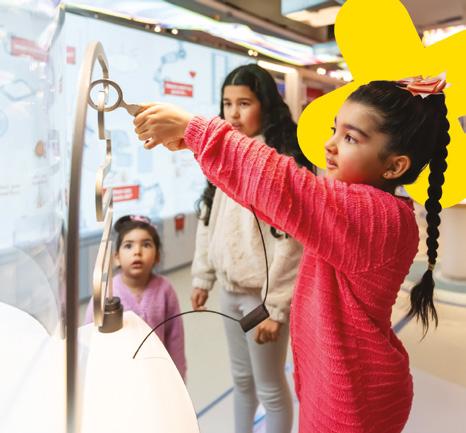

Autumn outdoor challenges for families
As the autumn approaches and the nights draw in once more, it can be a challenge to get outside. But fear not! The Outdoor Guide (www.theoutdoorguide.co.uk) is here with some great suggestions for outdoor activities for families to enjoy.

USE YOUR SENSES
It’s great to explore the outdoors using all of your senses. Imagine you have ears as large as an elephant - how many sounds can you hear? Imagine you have long tentacle arms like an octopus - how many different textures can you touch? Imagine you have the nose of a dog - how many different smells are in the air? Imagine you have the eyes of a hawkwhat can you see?

TREASURE HUNTING
A treasure is in the eye of the beholder and the natural world has many treasures just waiting to be found. Wander out and see how many you can find. Perhaps look for treasures that spell out the word NATURE - maybe you’ll find a nut, an acorn, a twig…


NATURE’S LARDER
In the autumn months, the hedgerows and woodlands are abundant with treats. Perhaps you’ll find some blackberries, sweet chestnuts or sloes to take home and make some tasty treats with. Remember not to take all of them from the tree or bush as the local wildlife will want to enjoy some too!

SLOW
IT DOWN
All too often we’re moving too quickly, focusing on our destination rather than where we are. It’s only when we really slow down that we start to notice everything that is happening around us. What’s the slowest animal you can think of? A sloth perhaps or a tortoise? Imagine you’re one of them - moving slowly and just noticing what is happening around you.

SMALL THINGS
Sometimes we’re all too busy looking at the big picture to notice the small details within it. Grab yourself a magnifying glass and go explore the little things that are all around you in the natural world. What’s the smallest thing that you can find?

MAP YOUR PATCH
Maps offer a birds’ eye view of an area, showing all the detail of what’s there. Can you create your own map of the area where you live? What are the things you can see as you walk along the path? Perhaps you could include trees, hedges, ponds, houses and road turnings.
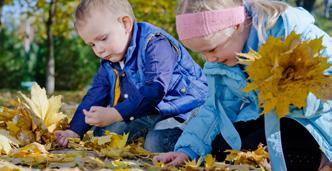
MAKING ART WITH THE PIECES
As the trees shed their leaves for another year, collect those you can find that have already fallen. Clearing a space on the ground as your canvas, use leaves and other objects you might have found to make your own works of art for others to enjoy.

BIRD FEEDERS
As we approach the cooler months, your local garden birds will be grateful for extra food that you can leave out for them. You can make your own bird feeders using things you find in the natural world. Open pine cones are perfect for this. Mix some seeds, oats, dried fruit or perhaps some grated cheese into some suet, lard or vegetable shortening and then smear it over the pine cone and hang somewhere the birds can easily reach it.
Editor
Linda Stone editor@familiesmanchester.co.uk
020 8241 0423
Printed by Buxton Press
Design by Rebecca Carr rebecca@familiesmagazine.co.uk
Next issue: November/December
Book by: 1 October
Families Manchester and Cheshire is available through nurseries, schools, libraries, selected shops and other points throughout the region. If you would like FREE copies for your organisation, please get in touch.
In this issue
The paper used in this magazine is made with or contains forest-based materials from FSCcertified forests and its use will not have harmed forests.

Well, it’s back to school already and soon the nights will start drawing in too! So make haste while there are still pleasant days and plenty of daylight left and enjoy some family adventures. To entertain the kids, why not pick an autumn challenge to help them make the best of the great outdoors?
In this issue, we have a bumper ‘back to school’ education feature. If you are thinking about secondary schools for your child, take a look at our article about the features of a good one. Also support your child with spelling and learn what to do to help them when failure and disappointment come along.
Halloween is a favourite time of year for many children so to get them in the mood, don’t forget to cut out and keep our spooky craft activity! You can also take a look at our top tips for enjoying Halloween with all ages of children.
Finally, in this issue, we have Tamatgotchi digital pets to giveaway! Apply inside.
May/June issue competition winners
Congratulations to all our winners. You can find a list at www.bit.ly/MJ24recipients
Families Manchester is a franchise of Families Print Ltd of 75 Lisbon Avenue, Twickenham, TW2 5HL. Families is a registered trademark of Families Print Ltd. All franchised magazines in the group are independently owned and operated under licence. The contents of Families Manchester are fully protected by copyright and none of the editorial or photographic matter may be reproduced in any form without prior consent of Families Manchester. Every care is taken in the preparation of this magazine but the franchise owner and Families Print Ltd cannot be held responsible for the claims of advertisers, nor for the accuracy of the contents, or any consequence thereof.


Whole School Open
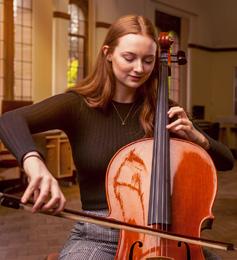
Morning
Saturday 12 October 2024
0-11 Years - 9.30am-1.00pm • 11-18 Years - 9.30am-1.45pm
With consistently high examination results, outstanding inspection reports, excellent facilities and incredible extra-curricular opportunities, this friendly school will enable your child to realise their full potential. Call 01204 840201 or visit www.boltonschool.org/visit-us to register to attend our Open Morning.

How to be great at spelling
By Zuzu Jordan
For children, learning how to spell isn’t just about passing school tests but being able to write words correctly in their extended writing. As adults, spelling is essential for effective writing, both in the professional world and on social media.
There are many tools that can help, such as auto correct, predictive text and even AI (Artificial Intelligence). However, children do not have ready access to these at school where they are expected to spell independently. Learning is key.
Here are some techniques:
Ensure that they know all the 40+ phonemes
Some children need repetition of the phonics taught in early years. Children will be taught the 26 letters of the alphabet, 44 different sounds called phonemes and the corresponding graphemes (the written symbols that represent a sound). Making sure they are secure in their phonics understanding can make a difference in their ability to spell words that follow patterns and rules.
Learn the exceptions to the rules
The many words that do not follow patterns can be confusing. Knowing what these words are and discussing how they are the ‘tricky’ words brings them to your child’s attention so they are mindful of them when writing. Also choose English over American spellings.
Rhyming games can really help
Children find similarities between words and this expands the number of words they can spell. For example, if they can spell ‘rain’ then they can spell ‘gain.’
Looking for words within words
This is a great way of breaking up larger words eg the word ‘independent’ has the words ‘in,’ ‘pen,’ ‘dependent,’ ‘dent.’ Equally, most words can be broken into syllables and each syllable usually has a vowel (or sometimes the letter ‘y’).
Seeing the shape of the word helps visual learners
For example, the word ‘tall’ has one tall letter and a short letter followed by two tall letters.
Rhyming and mnemonics

Boosting your child’s cognitive development through memory games will improve concentration and foster their problem-solving skills.
Kim’s Game involves showing children a range of objects, hiding them and seeing how many they can remember. Number sequence memory game helps with numerical memory by getting your child to repeat a sequence of numbers and then extending it each time.
Story recall is excellent for reading comprehension. Incorporating these games into daily routines will help children to learn how to retain important information at school.
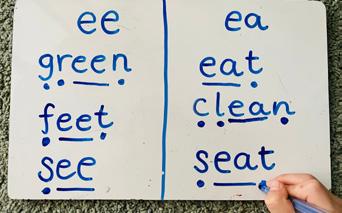
Mnemonics is like making up a story to help spell a word
For the word ‘because’ use the mnemonic ‘big elephants can always upset small elephants.’
The traditional method of ‘look, say, cover, write and check’ works for some children but comes with a warning
Not all children respond to this method and the words don’t always enter their long-term memory. Practising writing the word out helps your child become familiar with the shape of the word. Rainbow spelling is another visual way of learning spellings: maybe use one colour for a specific sound and different colours for the other letters.
Using technology and apps
The app Squeebles Spelling Test starts with a list from the national curriculum and you can upload your own words. Children can then practise their spellings independently.
Use different materials to practise writing the words
Like with paint or foam or in sand. Scrabble-like tiles can be bought from most hobby shops and are great for kinaesthetic learners as they can physically move the letters into the correct order. Equally, playing games like Scrabble and Hangman is also helpful.
Ultimately a multi-faceted approach will bring the best results when supporting your child’s spelling journey.
Zuzu Jordan is a Mastery for Maths specialist who has taught primary aged children for sixteen years and is interested in early years and home learning. For free homework and home learning resources, find her on Instagram at edumate_uk
Memory games
Rhyming is a powerful tool to raise phonics awareness and help kids remember tricky facts. For example, ‘wakey wakey rise and shine, 7 x 7 is 49’.
Mnemonics is another memory strategy that can be used in all subjects. It turns information into songs, acronyms, rhymes and other forms.
The spelling of ‘necessary’ can be remembered with this mnemonic: Never Eat Cake, Eat Salmon Sandwiches And Remain Young. A quick internet search shows many useful mnemonics to help your child in lots of subjects.


What does a good state secondary school look like?
By Melanie Sanderson
Choosing a secondary school is one of the biggest decisions you’ll ever make for your child. Very likely, your two priorities are whether your child will reach their academic potential and whether they will be happy there. Here are my tips on what to look for.
Hot-house or greenhouse?
Is the school educationally aspirational and how does this manifest? Look for relaxed and respectful teacher-pupil relations. They are key to successful learning. Is the library well-stocked and busy? Teacher recruitment and retention is challenging all schools. Ask pupils how often they have cover teachers.
Are pupils regularly assessed? Performance measures such as Progress 8 (see www.gov.uk) are good indicators of how a school adds value as they measure academic attainment rates over time. Are there programmes to stretch the more academic children? What about those with special educational needs and disabilities?
Breadth of curriculum
The best state schools offer and value a broad liberal arts education beyond the standard curriculum. For instance, Bohunt School in Hampshire ‘blew the socks off’ the Good Schools Guide with immersion classes in Mandarin. Some of the best state schools invest in top notch sports facilities and coaching, others have outstanding creative or performing arts spaces. Pick a school that suits your child’s strengths. Check out school notice boards and the school’s social media for co-curricular activities and trips the children are doing outside the classroom too.

When choosing a secondary school, DON’T…
Judge a school entirely by its Ofsted report: a report can quickly fall out of date and one word judgements cannot paint a full picture. Look for more nuanced information. Other local parents with children already at the school are a great place to start.
Take too much notice of social media community group grumbles about a school. These are usually led by a singular disgruntled parent.
Be swayed by dinner party bragging rights. The super-duper academic grammar school that everyone’s talking about may or may not be the best place for your child to flourish. Equally, don’t choose a school based on what YOU would have liked as a child.
Lie, cheat or change your religion to get your child into a particular school!
Be put off by a school that isn’t pristine. Look instead for cleanliness and orderliness. Ask to visit the toilets the pupils use – they’ll tell you a lot about the school’s values!

Pastoral
Good schools have clear systems. Every child is known; nobody slips through the net. Ask if reports and open evenings include pastoral updates. Does the school’s praise/discipline system flex to meet individual needs and align with your family values? Ask pupils what they do at break and lunch. Good schools include spaces for children to seek quiet reflection when needed.
Communication
Good schools also communicate well with parents. The tone of school newsletters and social media feeds can tell you a lot, while an active PTA is a sign of an engaged parent community. If you can, pass by the school at home time and observe pupil behaviour as they leave the site. Another top tip is to talk with pupils higher up the school. Would you be happy for your children to turn out like them?
Melanie Sanderson is Managing Editor of The Good Schools Guide (www.goodschoolsguide.co.uk), which contains frank, impartial reviews of schools. Its writers visit thousands of schools annually, speaking to Heads, teachers, pupils and parents.

The power of personalised learning
The Queen’s School understand that one size does not fit all when it comes to education which is why they celebrate the uniqueness of every pupil through personalised learning.
Nurturing an all-girls environment, small class sizes and individualised approach enables them to empower pupils to excel academically and beyond. Personalised learning is the cornerstone of success. It places each pupil at the heart of her educational journey, allowing learning at her own pace and in a preferred style to match individual strengths and interests.
Free from stereotypes and distractions, pupils thrive, embracing diverse academic pursuits and leadership opportunities. Girls build lifelong friendships and networks, preparing them not just for academic success but for a future where they don’t shy away from their aspirations.
Come and see for yourself why Queen’s is the place for your daughter to achieve her full potential.
Register for the next Open Event this October at www.thequeensschool.co.uk/open-events
Overcoming disappointment and failure
By Lisa Wander and Catherine Loble
Whilst studies show that children learn better when they experience failure, no parent likes seeing their child upset or disappointed. It feels right to want to keep them happy and content by taking steps to avoid anything seemingly harmful they encounter, whether that be through distraction, bargaining or even with a quick credit-card swipe.
However, whilst these quick wins feel better or even just simpler, safeguarding children from disappointment ultimately hinders them from developing resilience and confidence to progress from childhood to adolescence and in their adult life. When children are given the opportunity to struggle and sometimes fail, you are helping them develop essential social and emotional skills.
What is disappointment and failure? Disappointment is a natural response to failure. It involves the feelings of thwarted desire, loss and discouragement when children fail to fulfil their hopes and expectations or those of others. Children are going to feel disappointment when they don’t achieve their goals or believe that they have let you down.
The stigma surrounding failure is a significant issue that impacts a child’s development, confidence and willingness to take risks. Both close family and society place high expectations on children to succeed academically and socially, which can often lead to an intense fear of failure. The emphasis on continual testing in our education system reinforces a narrow definition of success and failure too. If a child does not reach certain

How to have a healthy perspective
Strategies to combat the stigma of failure
Understand that failure is a natural part of the learning process and see failures as opportunities for learning. Praise effort and persistence rather than just results and whilst showing your child empathy, avoid offering a consolation prize. Model your own healthy perspective on disappointment and allow your children to experience it, viewing stumbling blocks as opportunities.
Managing your expectations of your children
View your child as an individual. Children develop at different rates so don’t compare or be tempted to project your own challenges onto your children - they easily pick up on your negativity. Instead, be enthusiastic and positive, offer encouragement and support. Focus on positive, realistic expectations and celebrate effort as well as achievement. Help your child devise easily-achievable goals and separate them into manageable chunks, prioritising clear and consistent communication and expectations. Above all, validate their feelings which will help them develop perspective.

benchmarks, they are often labelled a failure. This can lead to a downward spiral effect with children reducing their efforts, giving up easily and not taking risks. Children who fall into this spiral may subsequently have little confidence, self-esteem and motivation to achieve future goals.
So how do we not feel completely defeated as parents when we have to watch our child suffer?
Placating your children doesn’t allow them to understand the root causes and figure out how to not feel disappointed in the future. Rather we should let them flex their muscles and with support, encourage them to find solutions themselves. In giving our children the necessary skills to manage disappointment, it is important to validate their feelings, show empathy and be mindful of how you react towards your own disappointments.
Lisa and Catherine are co-founders of Emparenting (www.emparenting.co.uk), supporting children, parents and families with the insights, skills and tools needed to nurture the development and well-being of the next generation.

How to view your child’s disappointments
According to the author Allison Armstrong, ‘many parents today try too hard to smooth away life’s rough edges in the hopes of keeping disappointment at bay. Children with no experience solving life’s little setbacks have a much harder time when they’re faced with the big ones.’ She suggests that parents should view their children’s disappointments as positive experiences that prepare them for adulthood.
‘Childhood disappointment is actually a practice lap on the course to adulthood. If you run interference whenever disappointment threatens, you’re setting kids up to run a marathon without ever letting them train for it’ Allison adds. Instead, reframe disappointment as a healthy and positive emotion that plays an essential role in children’s emotional, intellectual and social development, equipping them with resilience to meet and overcome failures in adult life. Albert Einstein said: ‘Failure is success in progress.’ It is not what we do for our children but rather how we guide them on their journey, which will make them successful, strong and confident individuals.
Introducing the classics to your child
By Erin Miller
At this year’s Hay Festival (the UK’s most prestigious literary event), children’s literature was a hot topic for discussion. Among those commenting were respected and prolific children’s authors, including Antony Horowitz CBE, author of the Alex Rider series, who observed the diminishing quality of children’s literature over the years, stating that ‘proper stories’ are being superseded by ‘silly books.’
There is no doubt that the classics are proper stories, characterised by their originality, complexity and the fact that they have stood the test of time. However, also appearing at the Hay Festival, the current Children’s Laureate, Joseph Coelho, claimed that today’s children would need a dictionary to read classics such as The Wind in the Willows and Treasure Island.
So, if classics are challenging, with sometimes outdated ideas (for example, around gender roles) is it desirable or necessary to get children reading them? My answer is a firm ‘yes.’
As an English teacher with over a decade of experience, I’ve seen hundreds of children connecting deeply with classic texts. I’ve also witnessed children making excellent progress in their reading skills when faced with books that might seem ‘too hard.’
Furthermore, having taught in the Far East, the Middle East and the UK, I know that many of the classics are enjoyed by children across the globe. Universal themes such as friendship touch everyone and are dealt with in the most insightful, exciting and even tragic ways in classic children’s literature.
It is recognised that reading for twenty minutes a day builds vocabulary and academic progress in all subjects. However,

How to support your child with the classics
As acknowledged already, the classics can be tough to digest for young readers.
Retellings for children can be a good way into the classics, as they will likely be written in modern language, with references that your child can understand. If you have a reluctant reader, try audiobooks first. Whilst listening is not found to accelerate academic progress in the way reading does, your child will still be soaking up the complex ideas within the classics.
Using a dictionary seems an archaic skill to some but all children should be encouraged to use physical dictionaries, as it gives them independence in their reading. If you allow screens, then the Kindle does have the benefit of being able to locate word definitions immediately.
Most importantly, have conversations with your child about the stories. Probe them about what they think about characters and what they believe the deeper ideas are in the stories. In my experience, these conversations at home are the most powerful in shaping young readers.

this does actually depend on what your child is reading. With both complexity of plot and language, the classics certainly will ensure vocabulary expansion and provide new or challenging ideas.
In addition, a broad knowledge of classic texts will equip your child with ‘background knowledge,’ which is an essential reading skill that has been proven to compensate for a weaker reading ability.
With AI generative platforms such a ChatGPT, there is a risk that today’s children could struggle with originality and creativity.
By encouraging your child to experience the classics, they will be armed with the stories that built today’s world. They will be exposed to a wide range of ideas to interpret and fuel their ideas in their own writing.
Erin Miller is a teacher with a keen interest in how research can be used in the classroom to improve learning.

Should I stay or should I go?
By Andrew Campbell
When you think it’s time for a change in an after-school club or class for your child, whether moving from dancing to swimming or to another class offering the same activity, take into consideration both the advantages and disadvantages.
One important benefit of changing extracurricular activities is the exposure to new challenges and opportunities. Trying something new can stimulate your child’s mind and body differently, fostering more well-rounded development. For instance, if your child has been involved in dancing, switching to swimming will introduce a new set of physical demands and skills.
Learning to adapt to new environments and expectations builds resilience and versatility; valuable traits that will serve children well throughout their lives.
Similarly, if your child no longer feels excited or challenged by the class they are taking but still wants to stick to the same activity, it could worth finding a new provider better suited to where they are now at.
Changing activities can also provide your child with the opportunity to make new friends. Each extracurricular environment has its unique social circle. Transitioning to a new activity introduces your child to peers they might not have met otherwise.
However, there are disadvantages. One key drawback is the potential loss of continuity with an instructor or teacher familiar with your child’s unique skills, capabilities and personality. A leader who understands your child’s strengths and weaknesses
Never miss an issue!
Sign up at familiesmag.co.uk/go


Confidence building fun with Perform

Perform is delighted to be expanding its popular classes in Cheshire.
Weekly drama, dance and singing classes for 4-7 and 7-12 year olds are designed to build a child’s confidence and give them a creative outlet to make friends and have fun.
Perform Heswall: Tuesdays at Heswall Hall, CH60 0AF
NEW Perform Hoole: Mondays at Hoole Community Centre, CH2 3AP
Perform West Kirby: Wednesdays at Westbourne Hall Community Centre, CH48 4DQ
Every child is welcome to try a FREE class to see if they like it. Just visit www.perform.org.uk/try

can tailor their guidance to maximise your child’s progress. Switching to a new class or activity means starting from scratch.
Moreover, changing activities can result in the loss of the progress achieved in the current activity. Many extracurricular pursuits, such as martial arts, dance or music, have structured grading systems that mark progress. Moving to a different activity might mean giving up hard-earned advancements and starting a new grading structure from the beginning.
Maintaining established friendships within the current activity should not be underestimated either. Consistent social interactions help children build strong bonds and a sense of belonging. Switching to a new activity involves entering an unfamiliar social environment where fitting in might be challenging. The risk of not integrating well into the new group could lead to feelings of isolation or disappointment.
Ultimately, deciding to change extracurricular activities should be guided by thoroughly understanding your child’s preferences, strengths and needs. Engage in open conversations with your child about their interests and feelings regarding both the current and prospective activities.

Scheduling after school activities for your child involves juggling various factors to ensure a balanced and enriching experience:
Cost: activities like music lessons, sports or dance can be costly. Parents need to budget carefully to avoid financial strain and assess whether the benefits justify the expense.
Loss of unstructured time: children need free play to develop creativity, problem-solving skills and social interactions. Overloading their schedule with structured activities can lead to burnout and deprive them of essential downtime.
Child’s interests and passions: engaging in activities they genuinely enjoy fosters a lifelong love for learning and personal growth. However, balance is key; too many commitments can lead to stress and fatigue.
Logistics: consider transportation and time management. Co-ordinating multiple activities may become challenging, impacting family time and routines.
Ultimately, the goal is to create a well-rounded schedule that promotes your child’s development while allowing for rest and spontaneous play.
Why snacks are important for toddlers
By Simone Ward
Once your baby turns one, it’s time to think about introducing snacks. Like all transitions, some toddlers are ready to jump in whilst others may need more time to adjust. They may only need one snack for a while or maybe two very light snacks.
Why snacks are important
Many kids would happily eat snacks all day and skip their main meals altogether. But while snacks can be massively appealing to kids (not always for the best of reasons), they are actually crucial.
Snacks keep kids going between meals
Toddlers have high energy needs and small tummies so they quickly burn through the foods they eat. They need an opportunity to fuel up and maintain their energy levels every two to three hours.
Snacks are essential for filling nutritional gaps
This is particularly important for kids who may not eat much at mealtimes. Kids have demanding nutritional needs but also everchanging appetites; they may eat very little at one meal or snack and lots at another or small amounts on each occasion. If they don’t eat much in one sitting, a snack a few hours later means they will not have to rely on limited eating windows to meet their nutritional needs.
How many snacks per day?
Depending on your child’s age and eating habits, two to three snacks a day is the general rule.

Younger toddlers may take time to build up to this number and all kids have differing appetites. Some children pack in a lot of food at mealtimes and will only need one snack or possibly none. This is okay too; children should never be encouraged to eat more than their bodies are telling them they need.
Be mindful that children’s fuelling needs can change over time or quite quickly, so continue to offer them the option of a snack (or snacks) in case they decide they need more food after all.
What about bedtime snacks?
These can be super helpful in ensuring that kids have had enough to eat but not all kids need or want them. Consider offering a bedtime snack if your child hasn’t eaten much of their evening meal, if bedtime is another couple of hours away or if you just feel your child would benefit from some extra nutrients or calories.
This is an edited extract from the book Feeding Toddlers by Simone Ward, published by Page Street Publishing.
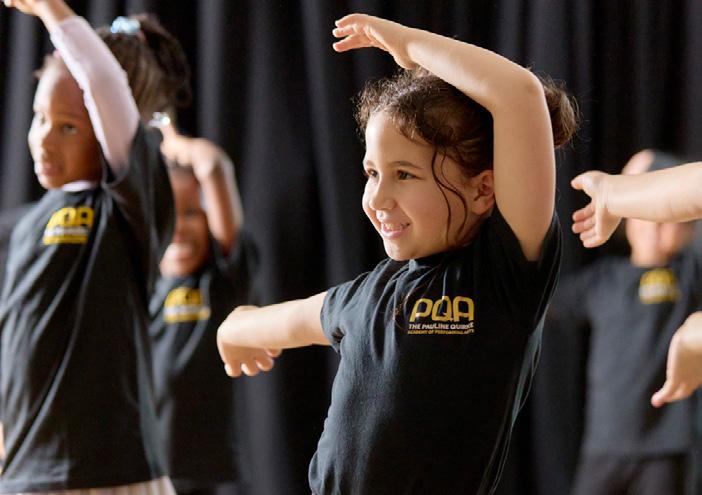
Is it ever okay to… brag about your child’s success?
By Ellie Malt
From the time we become parents, we can’t seem to help ourselves sharing our child’s milestones. But how does that make other parents feel? And does it ever stop? For instance, is it okay to tell others that your child has just got the lead in the school play or won a place at Cambridge? We asked two mums and found two very different points of view on this.
‘Being proud out loud can be a really positive thing to do in front of your child’

Being a parent can feel like a long line of failures and it’s very easy to get upset about the things that we find a struggle. For me, it’s a regular battle to get my child to leave their favourite computer game and do their homework instead. It feels like groundhog day when I constantly have to remind them to tidy their stuff.
So, when things do go well for a change, taking a moment to celebrate with others seems fair enough. I realise talking about your own kid’s achievements sometimes just comes across as boasting. But what might seem like bragging could be a parent trying to make up for a lack of achievement in another area. For example, if my child is bottom of the class in maths, I might feel it’s okay to talk up their sporting achievements to other parents. I realise that can be annoying for the parent whose child has no sporting ability but isn’t that all right if their child is doing really well in another area? They might be really advanced in maths, for example. I think it all balances out in the end.
Being proud out loud can be a really positive thing to do in front of your child as it can help boost their confidence and help them to feel good about themselves.
Clare, mother of three boys in Cheshire
It’s okay to be proud of your kid when…
Most parents agree it’s okay to talk about your child’s successes when you are with their grandparents or a close friend who also understands your challenges.
Balancing out triumphs with a few ‘fails’ can make it sound less like boasting. When sharing a win with another parent, try complimenting their child as part of the same conversation.
If a friend frequently tells you how great their kid is, why not share your child’s achievements too?
‘I don’t want them growing up trying to please others all the time’

When my eldest girl was born, I remember hearing from other new mums about how their babies were sleeping through the night and it generated a lot of anxiety for me. Then, later on, when the other mums were getting really excited about first steps, it was a similar feeling. Even though I told myself that every child will develop at their own pace, it’s still hard to hear when you feel your child is falling behind. I think it can be hurtful as well. I have seen parents brag about their child’s academic achievements to parents whose children have health problems and learning disabilities.
When other parents tell me how proud they are, it definitely leads on from comparison to a sense of judgement. Is that parent claiming responsibility for their children’s achievements? The achievement is probably nothing to do with parenting and just down to a unique genetic accident. I don’t love it when people send letters at Christmas to all their friends about all the successes in their family over the year. Now it’s even worse when every little milestone gets posted onto social media every day.
Although my girls like hearing me talk about their achievements, the main thing is they should be happy with themselves. I don’t want them to grow up trying to please others all the time or to only feel happy if they are doing something better than others.
Georgie, mother of two girls in Berkshire
Be careful not to boast when…
Hold off mentioning successes if your friend’s child is having difficulties. Even innocent conversations can seem insensitive eg talking about your child’s friendships is unlikely to go down well with the parent of a shy child.
Sharing how proud you are is risky with someone you haven’t seen for a while. Their child might be struggling, putting similar achievements out of reach. Sharing successes on social media means you will almost certainly be posting to someone currently feeling worried.
Making money real for kids in a cashless society
By Tanith Carey
To a young child, money is a magical commodity which allows grown-ups to go into shops and take anything they want. And it’s not just about understanding where money comes from and how it’s used: in an increasingly cashless society, money is even more of an abstract concept for kids to grasp.
In the days of coins and notes, children could see that money was something tangible, used for goods and services; and that it could run out. Now that we can just tap and go, kids don’t even see money being exchanged. So, it’s even harder for them to see that it’s not an unlimited resource. This requires parents to put a little more thought into helping kids understand how finances work. After all, managing money is a lifelong skill, bringing a range of key benefits.
As well as boosting their maths, money teaches kids how to control their impulses, develop patience, delay gratification; and ultimately spend wisely throughout life. Indeed, according to research by Cambridge University, attitudes to money are formed by around the age of 7.
Practical life lessons
Kids first grasp what money represents around the age of 6. Start by paying them their first pocket money in coins to make it tangible. Give them a see-through jar so they can see it disappear when they spend it. When you’re out and about, try to use cash as well as cards. Each time you do use your card, explain it’s the same as having the same amount taken out of your ‘jar,’ aka your bank account. As they get older, start sharing your own spending decisions too.

Tips for teaching younger children
Pay pocket money as in the real world: a fixed allowance on the same day each week, just like a wage and it’s their responsibility as to how to spend it. This teaches the value of money and that it’s not an unlimited resource.
Help them track their money on screen: if you give them a prepaid debit card, as many parents do, show them their balance on a family tablet. Watch the numbers go up and down together.
Let them earn: come up with some small jobs around your home and set a price for them. When you transfer their pay, let them see it pop up on screen. This will show how work earns money and how money gets transferred.
Play board games: Money-based board games like Monopoly and Pay Day still use old-fashioned play bank notes and can also introduce concepts like debt, mortgages, taxes and saving.
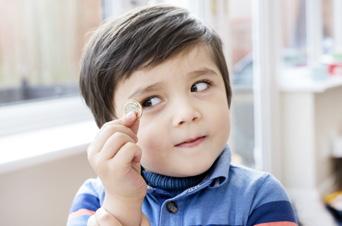
Talk about it. For example, when you go to buy an ice-cream with them, chat through the different prices for each item. Explain how the higher the cost, the more money will go out of your bank account. When you go to pay, rather than just tap, show your child the amount displayed on the card reader so they link what you’re buying to the money it costs.
Explain that if you spent all your money on ice-creams, you would have less to spend on other more important items you all need, namely food, clothes and travel.
Pocket money is one of the seventy five real world scenarios tackled in the book What’s My Tween Thinking? Practical Child Psychology for Modern Parent co-authored by Tanith Carey with Dr Angharad Rudkin, published by DK books and available now from www.bookshop.org


Tips for teaching older children
Share your spending decisions
Parents often don’t share with children how much money they have or how they make financial decisions. So kids may believe you have an unlimited amount and one day they’ll be the same. To help them think responsibly, calmly share some of your own money management decisions. When you’re out shopping, chat through your choices and how you compare prices. You might also show how your purchases affect your bank balance, so they learn basic cause-and-effect.
Talk about the difference between a ‘need’ and a ‘want’ In a tap-and-go society, it’s easier than ever to use a card to buy an item without thinking. That’s why it’s important to introduce some ‘friction’ to slow down the process. When you buy something, talk about the difference between a ‘need’ and a ‘want.’ Explain that ‘needs’ are everything you require to survive, like food, shelter. ‘Wants’ are complementary add-ons which are nice to have but you can live without them.

Tamagotchi Digital Pets
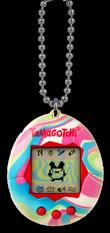











































What's On
All listings are correct at the time of publication. Please check with the venue before you visit in case anything has changed.
Sat 14 Sep
Buxton Opera House – Harold And The Purple Crayon www.buxtonoperahouse.org.uk/ event/harold-and-the-purplecrayon-pg
Sat 21 Sep
Z Arts Hulme – The Little Garden family theatre show www.z-arts.org/events/thehidden-garden
Buxton Cinema Pavilion Arts Centre – Ozi The Voice of The Forest www.buxtonoperahouse.org.uk/ event/ozi-voice-of-the-forest-pg
Sat 28 & Sun 29 Sep
Cockfields Farm Ashton under Lyne – Monster Trucks www.cockfields.co.uk/our-events
Sun 29 Sep
Lowry Salford – Little Red Riding Could a Fairytale Retold www.thelowry.com/whats-on/ little-red-riding-could
Thu 3–Sat 5 Oct
Octagon Theatre Bolton – The Gruffalo www.octagonbolton.co.uk/events/ the-gruffalo
Sat 5 & Sun 6 Oct
East Lancashire Railway – A Day Out With Thomas www.eastlancsrailway.org.uk/ events-activities/day-out-withthomas
Stockport Plaza – Dear Zoo Live! www.stockportplaza.co.uk/whatson/dear-zoo
Sun 6 Oct
Waterside Arts Sale – A Tiger’s Tale
www.watersidearts.org/whats-on
Fri 11 & Sat 12 Oct
Z Arts Hulme – Annie Jnr the musical www.z-arts.org/events/annie-jr
Sat 12-Thu 31 Oct
Cockfields Farm Ashton under Lyne – Pumpkin Patch/Mini Pumpkin Patch www.cockfields.co.uk/our-events
Sun 13 Oct
Lowry Salford – Grooving With Pirates
A funk and jazz adventure. Ages 3-7. www.thelowry.com/whats-on/ grooving-with-pirates
Middleton Arena – Amazing Animals

www.manchestertheatres.com/ event/amazing-animals
Fri 18–Sun 20 Oct
Lowry Salford – Dinosaur World Live! www.thelowry.com/whats-on/ dinosaur-world-live-2
Tue 22 to Thu 24 Oct
Z Arts Hulme – Room on the Broom www.z-arts.org/events/room-onthe-broom
Sat 19 Oct
Stockport Plaza – Wrestling www.stockportplaza.co.uk/whatson/wrestling-5
Sat 19 Sun 27 Oct
RHS Garden Bridgewater – Fun Outdoor Trail
Follow a fun outdoor trail and enjoy seed planting, craft workshops and more. Pre-book. www.rhs.org.uk/bridgewater
Sat 19–Thu 31 Oct
Tatton Park – Pumpkin Patch at The Farm www.tattonpark.org.uk
Tue 22 to Sat 26 Oct
Lowry Salford – The Elmer Adventure www.thelowry.com/whats-on/theelmer-adventure
Wed 23 Oct
East Lancashire Railway – The Wizarding Adventure www.eastlancsrailway.org.uk/ events-activities/the-wizardingadventure
Thu 24-Sat 26 & Thu 31 Oct
East Lancashire Railway –Halloween Ghost Trains www.eastlancsrailway.org.uk/ events-activities/halloweenghost-trains
Sat-Sun 26-27 Oct
Storyhouse Theatre Chester –Fantastic Mr Fox www.storyhouse.com/whats-on/ fantastic-mr-fox
Sat 26 Oct–Sun 3 Nov
Tatton Park – Skellies and Wellies In The Garden www.tattonpark.org.uk
Mon 28 Oct–Sun 3 Nov
Altrincham Garrick Theatre –The Wizard of Oz Family Musical www.altrinchamgarrick.co.uk/ shows/wizard
Wed 30 Oct
Buxton Pavilion Arts Centre –Trick & Treat Circus Live www.buxtonoperahouse.org.uk/ event/trick-and-treat-circus-live
Sat 2 & Sun 3 Nov
Z Arts Hulme – The Gruffalo www.z-arts.org/events/thegruffalo
Sat 2 & Sun 3 Nov
Cockfields Farm Ashton under Lyne – Fireworks At The Farm www.cockfields.co.uk/our-events
Sun 3 & Mon 4 Nov
Storyhouse Theatre Chester –Dear Zoo Live! www.storyhouse.com/whats-on/ dear-zoo-live

There’s so much for all the family to see and do at RHS Garden Bridgewater this autumn.
Head to the Woodland Play area set the kids loose on seesaws, spider-web nets, basket swings and clambering frames.
With dens to build and magical Hobbit Houses, mud kitchens and fairy homes to play with, their imaginations can roam as free as their spirits. All while you enjoy the show with a delicious coffee from the café.
Book your visit today at rhs.org.uk/bridgewater
Make hanging pumpkins for a twig tree
We asked our friends at Hobbycraft (www.hobbycraft. co.uk) for a spectacularly spooky Halloween craft activity for parents to do with their kids and they’ve come up with these cute pumpkins to hang on a twig tree.

Instructions:

Step 1:
Print off the pumpkin template at www.bit. ly/pumpkintem or get creative and draw out your own pumpkin shape. Cut it out.

Step 6:
Take a 15cm piece of cord and glue it to the front of the pumpkin to make a hanging cord.
You will need black ribbon, A4 felt sheets in orange, green and pink, soft toy filling, black card, a glue gun, scissors and a pen.
(All materials plus twig trees can be purchased at Hobbycraft).

Step 2:
Use a pen to trace your pumpkin template onto a folded piece of felt. Cut this out to give you two identical pumpkins.

Step 7:
Trace the pumpkin stalk onto some green felt and cut out two pieces.


Step 3:
Use a hot glue gun to put a line of glue around the edge of one pumpkin and stick the other on top. Leave the bottom open.

Step 8:
Glue one piece of the green felt stalk to the front and one to the back, sandwiching the hanging cord in between.
andCutout keep

Step 4:
Stuff the pumpkin with a small amount of the soft toy filling.
Step 5:
Use hot glue to close the pumpkin.

Step 9:
Cut face details out of some black card and add to the pumpkins for a spooky finishing touch.


















